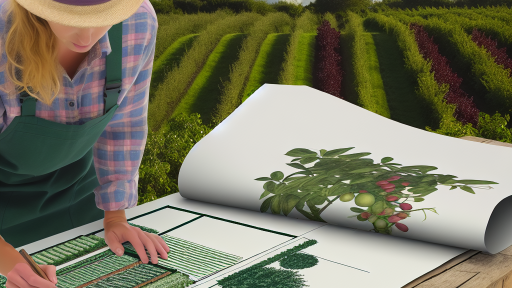Understanding the Concept of Edible Landscaping
Defining Edible Landscaping
Edible landscaping combines aesthetics and food production.
It allows us to grow fruits, vegetables, and herbs in our gardens.
Moreover, this practice promotes sustainability and resourcefulness.
Benefits of Edible Landscaping
One major benefit is enhanced biodiversity in the garden.
This approach attracts beneficial insects and pollinators.
Additionally, it provides fresh produce for our kitchens.
It also reduces the need for store-bought groceries.
Furthermore, edible landscaping can lower water usage.
Choosing the Right Plants
Selecting appropriate plants is crucial for a successful edible landscape.
Consider your local climate and soil conditions when choosing.
Native plants often thrive best in their natural environments.
Mixing ornamental and edible plants creates an attractive layout.
Design Principles of Edible Landscaping
Effective design balances functionality and beauty.
Start by assessing the space and sunlight available.
Incorporating varied heights enhances visual interest.
Transform Your Agribusiness
Unlock your farm's potential with expert advice tailored to your needs. Get actionable steps that drive real results.
Get StartedGroup plants with similar water and sunlight needs together.
Lastly, consider using vertical gardening techniques to save space.
Spring Preparation: Selecting the Right Edible Plants
Understanding Your Growing Zone
Start by determining your growing zone.
Many plants thrive in specific climate conditions.
Consult local gardening resources for guidance.
Online tools can also help you identify your zone.
Choosing Suitable Edible Plants
Selecting the right plants is crucial for success.
Consider both climate and soil type when choosing.
Herbs like basil and rosemary are great options.
Leafy greens such as spinach and kale thrive in spring.
Root vegetables like carrots and radishes also do well.
Diversity in Plant Selection
Diversity enhances your garden’s resilience.
Include a mix of annuals and perennials.
Annuals will provide quick yields, while perennials return each year.
Try different varieties within each category for variety.
Planning for Seasonality
Timing is important for planting your chosen edibles.
Focus on cool-season crops for early spring planting.
Monitor the last frost date for your area.
Following this will help ensure successful growth.
Soil Preparation and Nutrition
Good soil is the foundation of a healthy garden.
Test your soil to determine its pH and nutrient levels.
Amend your soil based on the results of your tests.
Adding compost improves soil texture and fertility.
Maintenance and Care
Regular maintenance is essential for healthy plants.
Showcase Your Farming Business
Publish your professional farming services profile on our blog for a one-time fee of $200 and reach a dedicated audience of farmers and agribusiness owners.
Publish Your ProfileWatering consistently helps maintain soil moisture.
Weed control keeps your plants stress-free and thriving.
Also, consider companion planting to enhance growth.
Summer Care: Maintenance Tips for Thriving Edible Gardens
Regular Watering Practices
Water your garden deeply and consistently during the summer months.
Aim for at least an inch of water per week, including rainfall.
Use a rain gauge to measure how much water your garden receives.
Consider watering early in the morning to minimize evaporation.
Mulch your garden beds to retain moisture and keep the soil cool.
Pest and Disease Management
Keep a close eye on your plants for signs of pests and diseases.
Identify common pests like aphids, hornworms, and spider mites promptly.
Use insecticidal soap or neem oil as safer treatment options.
Encourage beneficial insects, such as ladybugs and lacewings, into your garden.
Rotate crops each season to minimize disease buildup in the soil.
Weed Control Strategies
Regularly check your garden for unwanted weeds competing for nutrients.
Hand-pull weeds early in the morning when the soil is moist.
Lay down mulch to suppress weed growth throughout the summer.
Consider using landscape fabric for high-traffic pathways to prevent weeds.
Fertilization Techniques
Apply organic fertilizer to promote healthy growth in your edible plants.
Use compost or well-rotted manure to provide essential nutrients.
Feed your plants every four to six weeks to support summer growth.
Mix slow-release fertilizers into the soil for consistent feeding.
Harvesting and Pruning
Regularly harvest fruits and vegetables to encourage further growth.
Prune plants to improve air circulation and light penetration.
Remove any dead or diseased foliage promptly to prevent spread.
Enjoy your homegrown produce often to appreciate your hard work.
Use fresh herbs in cooking to enhance flavors and utilize your garden’s bounty.
Explore Further: Optimizing Light for Hydroponic Plants
Autumn Harvesting
Preparing for Harvest
Gather your tools before starting the harvest.
Use sharp shears or a harvesting knife.
Ensure you have baskets or containers ready.
Check the weather forecast to avoid rain.
Timing Your Harvest
Know when each crop is at its peak.
Pick fruits and vegetables in the morning.
Cool temperatures enhance flavor and texture.
Avoid harvesting during extreme heat or frost.
Best Practices for Collecting Edible Crops
Gently cut or twist produce from the plant.
Handle fragile items with care to prevent bruising.
Store harvested items in a cool, dry place.
Insulate delicate crops from harsh conditions.
Post-Harvest Handling
Wash the produce gently to remove dirt.
Showcase Your Farming Business
Publish your professional farming services profile on our blog for a one-time fee of $200 and reach a dedicated audience of farmers and agribusiness owners.
Publish Your ProfileDo not soak them in water for long periods.
Pat fruits and vegetables dry with a cloth.
Store them in breathable containers to maximize freshness.
Preserving Your Harvest
Consider canning or freezing excess produce.
Make jams or jellies from fruits you can’t consume right away.
Dry herbs to enhance their shelf-life.
Share surplus crops with friends and neighbors.
Delve into the Subject: Hydroponics vs. Traditional Farming Methods
Winter Planning: Protecting Perennials and Preparing for Spring
Understanding the Needs of Perennials
Perennials require special care during winter months.
First, assess the condition of your plants.
Remove any dead or damaged foliage to promote health.
Next, ensure each perennial is well-hydrated before frost.
This preparation helps them withstand harsh temperatures.
Mulching for Protection
Apply mulch around the base of perennials.
Mulch acts as insulation against cold weather.
It also retains moisture during dry winter months.
Choose organic materials like straw or wood chips.
Ensure the mulch layer is thick enough for effectiveness.
Constructing Protective Barriers
Consider using protective barriers for vulnerable plants.
Row covers can shield plants from freezing temperatures.
Plastic or fabric covers allow sunlight while providing warmth.
Make sure not to suffocate the plants underneath.
Planning for Spring Growth
Start planning for spring as winter progresses.
Evaluate your garden layout and plant selections.
Take note of which plants thrived last year.
Consider adding new edible varieties for diversity.
Pre-order seeds from local suppliers to ensure availability.
Tool Maintenance and Preparation
Winter is an ideal time to maintain your gardening tools.
Clean and sharpen your tools to ensure efficiency.
Inspect for any rust and apply protective coatings.
Store them in a dry place to prevent damage.
This preparation pays off when spring gardening begins.
Engaging with the Community
Join local gardening clubs or online forums during winter.
Engaging with other gardeners offers valuable insights.
Share your experiences and learn from others’ successes.
Attend workshops to gain new techniques and knowledge.
This community connection enhances your gardening skills.
Find Out More: Best Soil Mixtures For Container Farming Success

Seasonal Planting Calendar: Timing for Different Regions
Understanding Your Climate Zone
First, identify your climate zone.
This knowledge influences your planting schedule.
Showcase Your Farming Business
Publish your professional farming services profile on our blog for a one-time fee of $200 and reach a dedicated audience of farmers and agribusiness owners.
Publish Your ProfileFor example, USDA plant hardiness zones offer guidance.
Check cold hardiness for consistent growth.
Additionally, consider regional temperature patterns.
Spring Planting
Spring is an exciting time for edible landscaping.
In most regions, this season begins in March.
Now is the perfect time to plant cold-tolerant crops.
Grow lettuce, spinach, and peas as early options.
Gradually, you can transition to warm-weather crops.
Consider tomatoes, peppers, and squash in late May.
Summer Maintenance
During summer, ensure proper care for your plants.
Regular watering is essential for their health.
Mulching helps retain moisture in hot months.
Additionally, monitor for pests and diseases.
Harvest crops promptly to encourage continued growth.
Fall Planting
Fall offers a second chance for planting in some regions.
Consider cool-season crops like broccoli and carrots.
Sow these seeds in late summer to early fall.
Cover them with frost protection as temperatures drop.
Furthermore, fall is ideal for planting garlic and onions.
Winter Preparations
Winter requires preparation for the next season.
Protect tender plants from frost using row covers.
Plan your spring garden layout during this quiet time.
Additionally, start seedlings indoors if possible.
Use grow lights to ensure strong, healthy plants.
See Related Content: Organic Practices For Urban Gardeners
Companion Planting: Maximizing Yield and Pest Control Throughout the Seasons
Benefits of Companion Planting
Companion planting enhances garden productivity.
It helps in managing pests naturally.
Additionally, it can improve soil health.
Choosing the Right Plants
Different plants offer unique benefits when paired together.
For instance, tomatoes thrive beside basil.
Moreover, marigolds repel harmful nematodes.
Spring Planting Strategies
In spring, focus on planting fast-growing crops.
Consider pairing lettuce with radishes for a quick harvest.
This combination maximizes garden space efficiently.
Summer Companion Planting
During summer, aim for fruits and vegetables.
Cucumbers grow well alongside sunflowers.
This partnership provides shade and support.
Autumn Preparations
In autumn, prioritize crops that can withstand cooler temperatures.
Consider planting garlic with roses for pest control.
This combination works well for both aesthetics and yield.
Showcase Your Farming Business
Publish your professional farming services profile on our blog for a one-time fee of $200 and reach a dedicated audience of farmers and agribusiness owners.
Publish Your ProfileWinter Cover Crops
Even in winter, you can benefit from planting cover crops.
Legumes enrich the soil with nitrogen.
While oats prevent erosion and improve soil structure.
Incorporating Seasonal Decorations
Enhancing Aesthetic Appeal
Seasonal decorations can elevate the visual charm of edible landscapes.
They bring vibrant colors and textures to your garden.
Brightly colored fruits and leaves contrast beautifully with traditional decor.
Consider using pumpkins or gourds during fall for a festive touch.
Functionality in Decor
Decorations should also serve a purpose in your garden.
Utilize planters and hanging baskets that provide both beauty and utility.
For instance, an herb planter can enhance both looks and flavors.
Choose decorations that can be interchanged seasonally for versatility.
Highlighting Seasonal Changes
Use decorations to celebrate the changing seasons.
In spring, add colorful flowers alongside your edible plants.
During winter, evergreen branches can add warmth and greenery.
These elements remind us of nature’s cycles and beauty.
Creating a Harmonious Design
Strive for balance between aesthetics and function in your landscaping.
Align your decorations with the plants for a cohesive look.
For example, pairing berry bushes with rustic ornaments can be striking.
Remember, the goal is to create a space that is enjoyable and productive.
Additional Resources
Is opening a nursery/garden center a worthwhile business venture …
Gardening Triumph: Succession Planting Mastery in Mid-July




